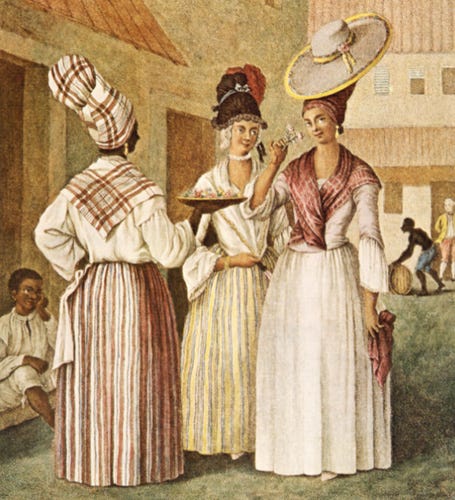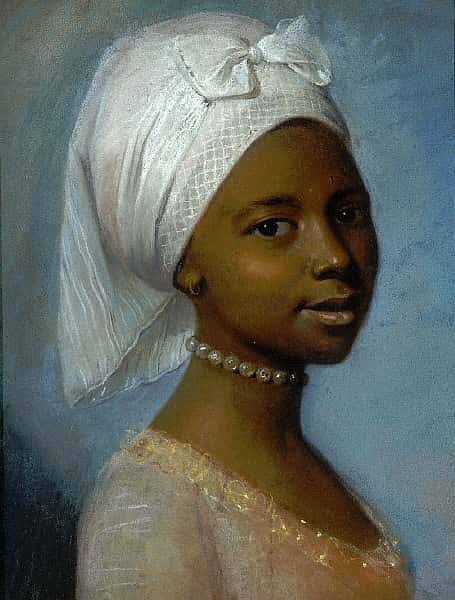How Black Women turned oppressive headwrap laws into fashion statements
Black Women ARE the culture!
Good afternoon, Brunchers! Do you wear a headwrap? Or know someone who does? Now if you say you don’t, you telling stories chile, because you know me! Everything, literally everything, has an origin, and in this country its origins are based in racism. Lawd hammercy! When I sent out Wednesday’s Lagniappe, chatting about The Tignon Laws, my friend Brittanie emailed me back and said she’d heard about the laws and that legitimately made me smile! I enjoy chatting about my interest and little known facts with folks who may not know, but I also really love having in depth conversations about topics that have been discussed many times. Alright sha, let’s get into it!
In 1786 Spanish colonial Louisiana, a battle of dignity and defiance was being waged through an unlikely medium: fashion. When Spanish colonial governor Esteban Rodríguez Miró enacted the Tignon Laws from his seat of power in New Orleans, he couldn't have predicted how his attempt at racial oppression would transform into one of history's most compelling stories of creative resistance.
Understanding the Tignon Laws requires stepping into the complex social landscape of colonial Louisiana. While New Orleans served as the colonial capital and a major center of free people of color, known as "gens de couleur libres," these communities existed throughout Spanish Louisiana. Many of these free women of color had inherited wealth or built successful businesses across the region. They wore the finest European fashions, styled their hair in elaborate ways, and adorned themselves with expensive jewelry and accessories. Their beauty, sophistication, and economic success attracted attention from both white and Black men, creating what the colonial authorities saw as a threat to the social order.
The Tignon Laws were part of Governor Miró's "Bando de Buen Gobierno" (Edict of Good Government), a set of regulations meant to control various aspects of colonial life. The laws specifically required Black and mixed-race women, whether free or enslaved, to wear head coverings called "tignons." These head coverings were meant to mark them as members of the slave class and, importantly, to suppress what colonial authorities called the "excessive attention to dress" among free women of color.
But the women of Louisiana had other plans.
Instead of accepting the tignon as a badge of shame, these women transformed it into a symbol of defiance and beauty. They chose luxurious fabrics like silk and taffeta in vibrant colors and patterns. They adorned their tignons with jewels, ribbons, and feathers. The wrapping styles became increasingly elaborate, with complex knots and folds that turned the simple head covering into a stunning fashion statement. Some women even coordinated their tignons with their dresses and accessories, creating complete ensembles that showcased their fashion sense and creativity.
The transformation was so complete that the tignon became a coveted fashion accessory. Even some white women began wearing decorated head wraps, though without the legal requirement to do so. This adoption created an interesting dynamic where the very symbol meant to distinguish and diminish Black women had become a sought-after fashion statement across racial lines.
The story of the Tignon Laws represents more than just a fashion revolution. It exemplifies how marginalized communities have historically used creativity and style as tools of resistance. These women understood that fashion wasn't just about appearance – it was about identity, dignity, and power. By transforming the tignon from a symbol of oppression into one of beauty and pride, they demonstrated that the human spirit cannot be suppressed by law or social convention.
The influence of this resistance extends far beyond its historical moment. The tradition of head wrapping among Black women continues to hold deep cultural significance today. From elaborate church hats to modern-day head wraps and turbans, these accessories often serve as both fashion statements and connections to this rich history of resistance.
Contemporary fashion designers and artists frequently draw inspiration from this history. The tignon has influenced collections at major fashion houses and appears regularly in contemporary African American art. Its legacy can be seen in the work of modern milliners and in the growing popularity of head wrapping among young Black women who view it as a connection to their heritage.
The story also resonates with broader themes of cultural appropriation and reclamation in fashion. When Black women today choose to wear head wraps, they're not just making a fashion choice – they're participating in a centuries-old tradition of turning symbols of oppression into expressions of pride and cultural identity.
The Tignon Laws remind us that fashion has always been political. What we wear, how we present ourselves, and how society attempts to control these choices are deeply connected to power structures and social hierarchies. But more importantly, this history shows us how creativity and dignity can triumph over oppression.
Today, as we continue conversations about racial justice, cultural expression, and fashion freedom, the story of the Tignon Laws offers valuable lessons. It reminds us that resistance doesn't always look like direct confrontation – sometimes it looks like beauty, creativity, and style. It teaches us that when faced with attempts to diminish their humanity, people can respond by amplifying their dignity and grace.
The next time you see someone wearing an elaborately tied head wrap, remember the women of colonial Louisiana. Remember how they took a law meant to shame them and transformed it into a celebration of their creativity and resilience. Their legacy lives on in every fold, knot, and twist of fabric that adorns the heads of their descendants, both literal and spiritual.
In an era when we're still grappling with questions of representation, cultural expression, and equality, the story of the Tignon Laws remains powerfully relevant. It stands as a testament to the enduring truth that true liberation often begins with the courage to turn symbols of oppression into statements of pride. Next time you see someone with a head wrap, remember where it came from, and how Black and mixed race women turned oppression into resistance. See you next time!
Brya








